[Contents]
1) Image classification 1
2) Annotation data efficient learning
Image classification 1
- 우리는 오감 중 특히 시각에 의존하여 사물을 바라보고 이해하며 살아가고 있다
- 동일한 프로세스를 컴퓨터에 적용한 컴퓨터 비전이다
- 여기에서는 컴퓨터 비전 (CV)의 첫 시간으로 CV에 대해 짧게 소개하고, CV에서 가장 기본적인 task, image clasiification을 소개한다
- Image Classification은 사진이 주어졌을 때 특정 카테고리로 분류하는 task이다
- 이번에는 먼저 기존의 머신러닝과 구분되는 딥러닝을 사용한 Image classification의 특징에 대해서 배운다
- 다음으로 대표적인 CNN 모델인 AlexNet을 배우고 이에 대한 실습을 진행한다
- 끝으로 가장 유명한 classification 모델 중 하나인 VGGNet에 대해 배운다
Further Reading
Course overview
Why is visual perception important?
-
Artificial Intelligence (AI)?
- 사람의 지능을 computer system으로 구현 하는 것
- 지능 : 인지능력, 지각능력, 기억과 이해 및 사고 능력까지 포함
-
Perception to system (지각능력)
- 시스템에서 입력과 출력 데이터에 관련된 것
- As humans grow, we learn about the world by interacting with it
- We gather informative signals from multi-modal association
- Developing machine perception is still an open research area

-
시각지각 능력이 가장 중요하다
- 왜냐하면 다른 오감에 비해서 압도적으로 시각에 많이 의지해서 살아가기 때문이다
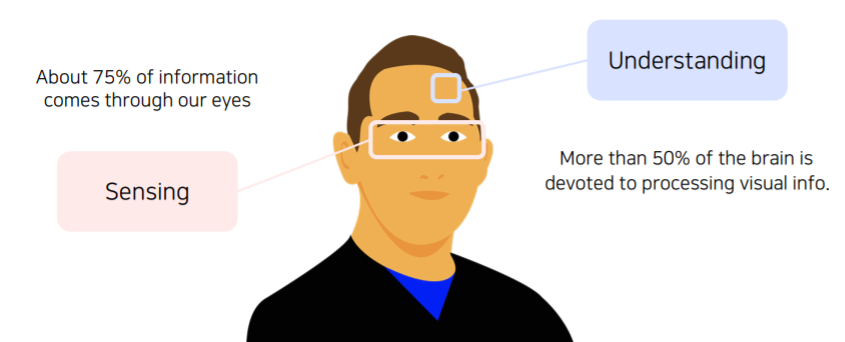
- 왜냐하면 다른 오감에 비해서 압도적으로 시각에 많이 의지해서 살아가기 때문이다
What is computer vision?
- 사람이 정면을 이해하는 과정

- 컴퓨터가 정면을 이해하는 과정

- rendering : 정보를 통해서 2d 이미지를 drawing 하는 테크닉
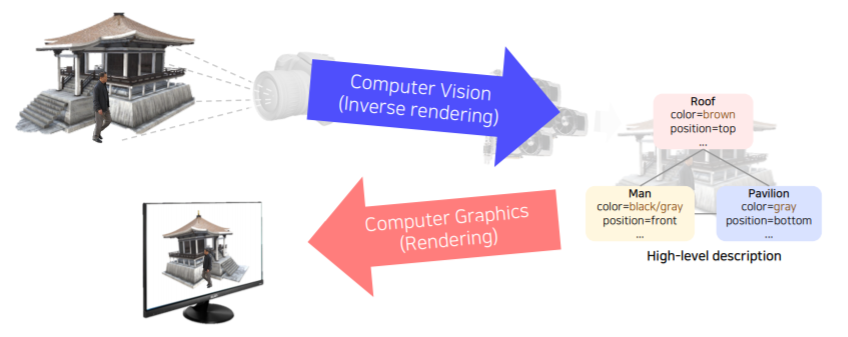
- Visual perception & intelligence
- Input : visual data (image or video)
- Class of visual perception
- Color perception
- Motion perception
- 3D perception
- Semantic-level perception
- Social perception (emotion perception)
- Visuomotor perception, etc.
- Also, computer vision includes understanding human visual perception capability!
- Our visual perception is imperfect
- to develop machine visual perception,
- we need to understand the good and bad of our visual perception
- we need to come up with how to compensate for the imperfection
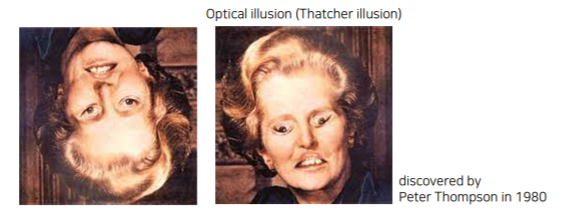
- to develop machine visual perception,
- How to implement?
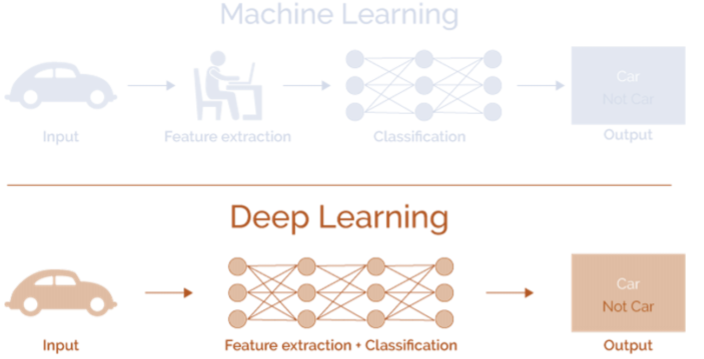
what you will learn in this course
- Fundamental image tasks
- deep learning based tasks
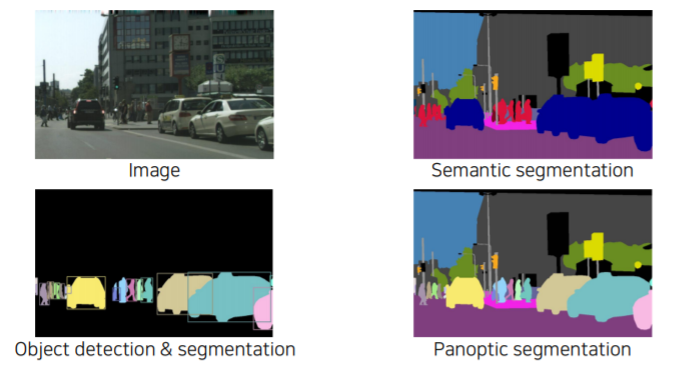
- deep learning based tasks
- Data augmentation and knowledge distillation
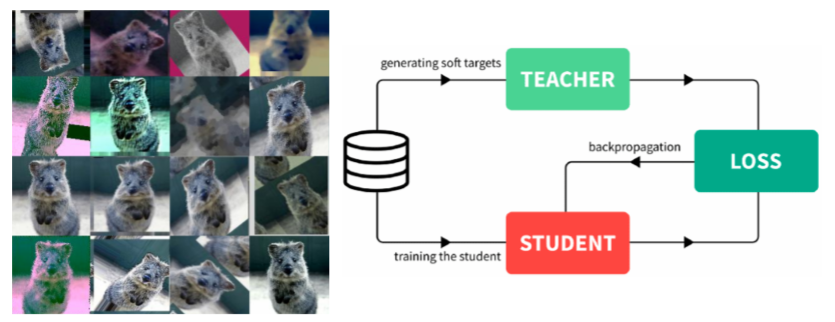
- Multi-modal learning (vision + {text, sound, 3D, etc.})
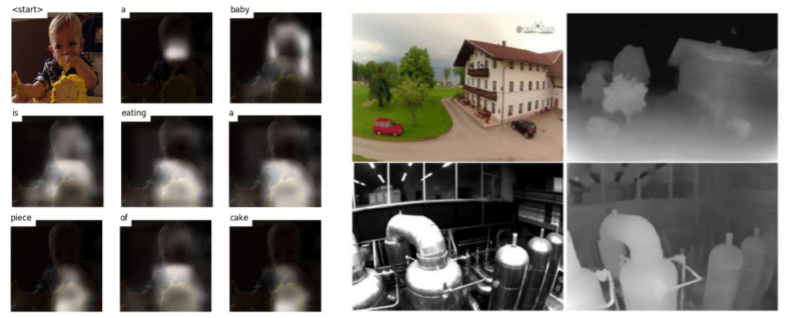
- Conditional generative model
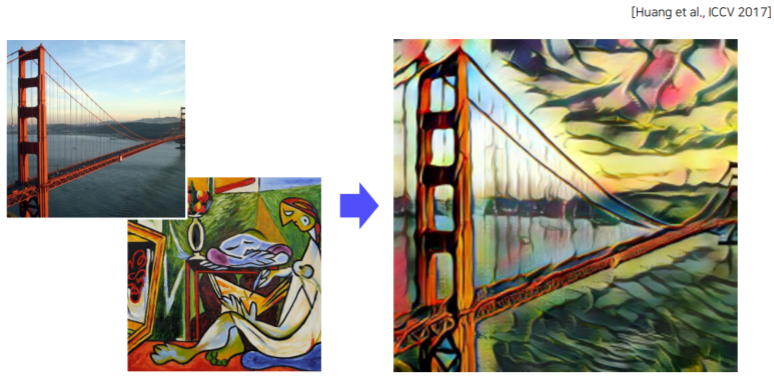
- Neural network analysis by visualization
- 딥러닝을 디버깅하고 이해하기 위한 visualization tool들도 배운다
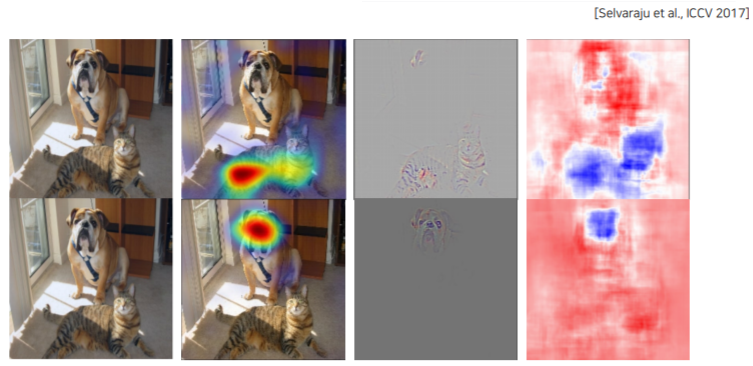
- 딥러닝을 디버깅하고 이해하기 위한 visualization tool들도 배운다
What is Classification
- Classifier: A mapping f(.) that maps an image to a category level
- 어떤 물체가 영상속에 들어있는지 분류
- 입력 : 영상
- 출력 : 영상이 해당하는 카테코리(클래스)
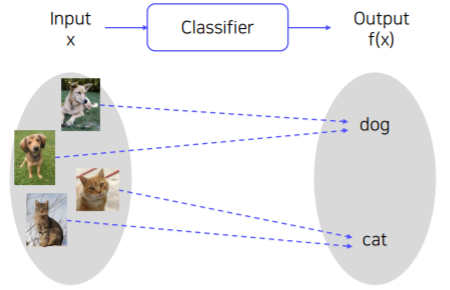
An ideal approach for image recognition
- What is we could memorize all the data in the world?
- All the classification problems could be solved by k Nearest Neighbors (k-NN)
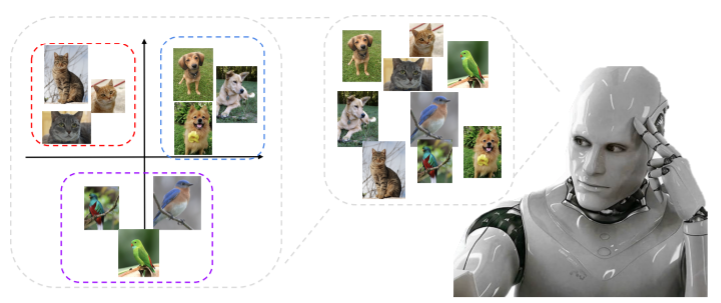
- All the classification problems could be solved by k Nearest Neighbors (k-NN)
- k Nearest Neighbors (k-NN)
- classifies a query data point according to reference points closest to the query
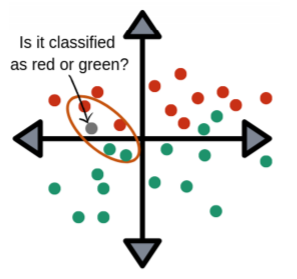
- classifies a query data point according to reference points closest to the query
- All the classification problems could be solved by k-NN!
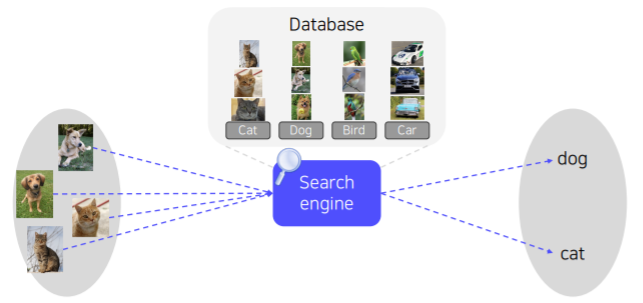
- Is it realizable?
- 정말 많은 데이터가 있다면
- 검색하는데 걸리는 시간이 데이터 수에 비례해서 증가하게 되고
- 메모리 용량도 데이터 수에 비례해서 증가한다
- 따라서 아무리 컴퓨터가 빨라져도 이세상에 모든 데이터를 담기에는 부족하다
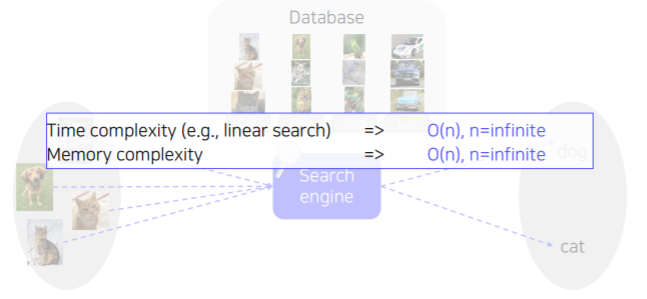
- 정말 많은 데이터가 있다면
Convolutional Neural Networks (CNN)
- Compress all the data we have into the neural network
- 데이터가 너무 많으면 시스템 복잡도가 올라가서 실현할 수 없다
- 방대한 데이터를 제한된 복잡도의 시스템(neural networks)에 압축해서 녹여놓는거라고 볼수 있다
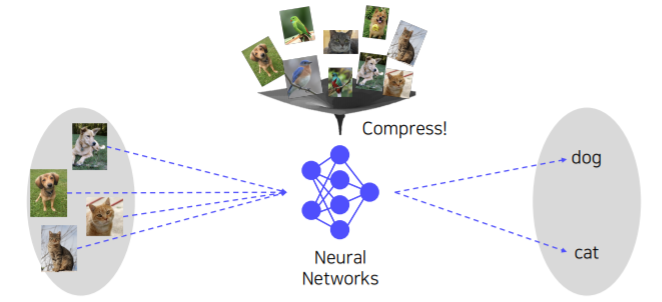
- let's look at a simple model(singal layer neural network aka. fully connected layer), perceptron, that takes every pixel of an image as input
- But, is this model suitable for solving the image classification problem?

- Visualization of single fully connected layer networks
- 문제 1) layer가 한층이라 단순해서 평균 이미지들 같으거 이외에는 표현이 안된다
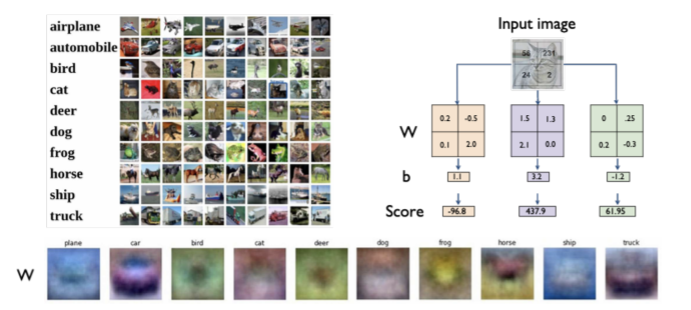
- 문제 1) layer가 한층이라 단순해서 평균 이미지들 같으거 이외에는 표현이 안된다
- A problem of single fully conneceted layer networks
- 문제 2) 적용시점(test time)때의 문제
- 학습시에는 영상이 가득찬 하나에 물체에 대해 학습해서 그 클래스에 대한 대표적인 패턴을 학습했다고 볼 수 있다
- 적용시점에 조금이라도 다른 패턴을 적용할 경우 학습동안에 본적이 없기 때문에 조금이라도 템플릿에 위치나 스케일에 맞지 않으면 굉장히 다른 결과나 해석을 내놓는다
- 위 문제점들을 해결하기 위해서 cnn 이 등장한다
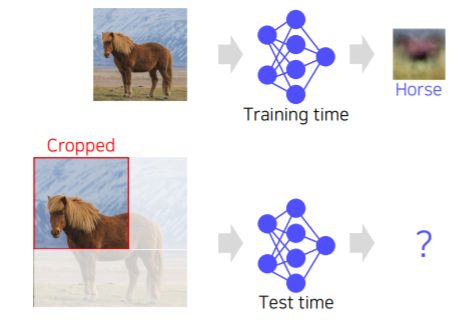
- 하나의 특징을 뽑기위해서 모든 픽셀을 고려하는 fully connected layer 대신에 하나의 특징을 영상의 공간적인 특성을 고려해서 국부적인 영역들만 connection을 고려한 layer(locally connected layer) 사용
- 필요한 parameter 가 획기적으로 줄어든다
- 더 적은 파라미터로도 효과적인 특징을 추출할 수 있고 또한 overfitting도 방지한다
- Convolution neural networks are locally connected neural networks
- local feature learning
- parameter sharing
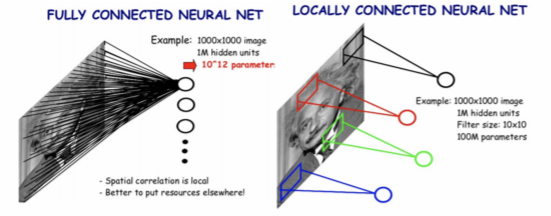
- CNN is used as a backbone of many CV tasks
- in this lecture, we will focus on image-level classification
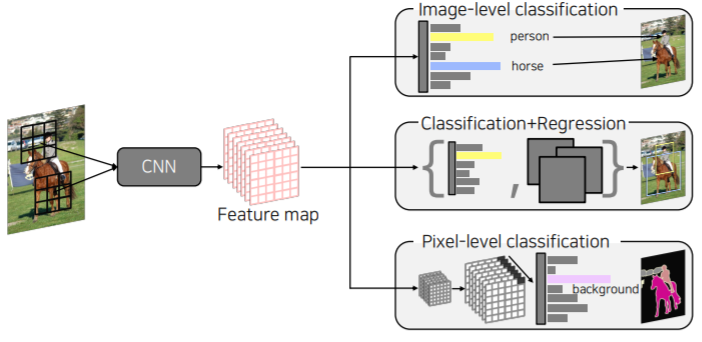
CNN architectures for image classification 1
Brief History
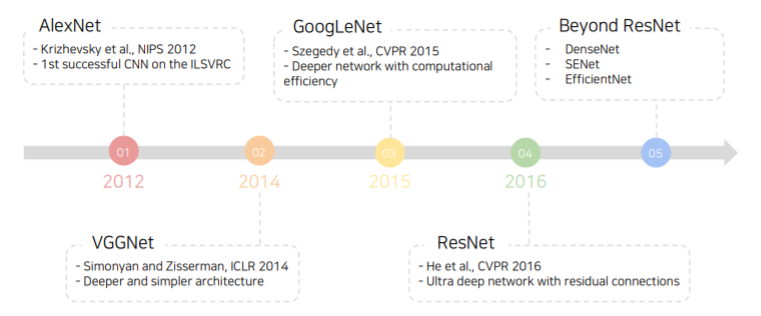
AlexNet
- LeNet-5
- A very simple CNN architecture introduced by Yann LeCun in 1998
- overal architecture: Conv - Pool - Conv - Pool - FC - FC
- Convolution: 5 x 5 filters with stride 1
- Pooling: 2 x 2 max pooling with stride 2

- A very simple CNN architecture introduced by Yann LeCun in 1998
- Similar with LeNet-5, But
- Bigger (7 hidden layers, 605k neurons, 60 million parameters)
- Trained with ImageNet (large amount of data, 1.2 millions)
- Using better activation function (ReLU) and regularization technique (dropout)
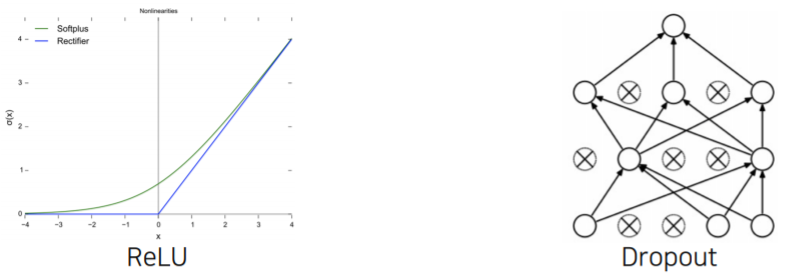
- Overal architecture
- Conv - Pool - LRN - Conv - Pool - LRN - Conv - Conv - Conv - Pool - FC - FC - FC
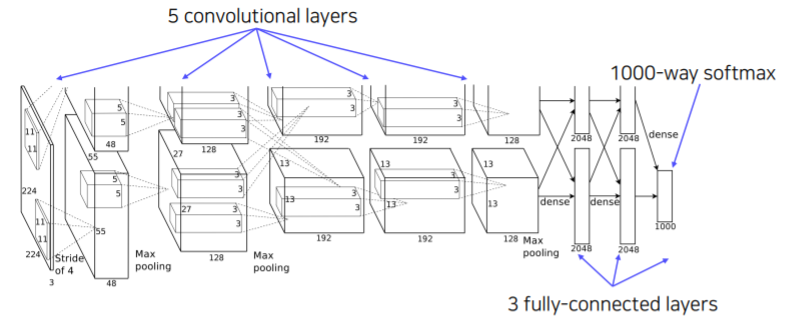
- network path 가 2개로 나뉘어져 있다
- 이때 당시에는 GPU 메모리가 모자라서 network를 절반씩 나누어서 각각 2개의 GPU에 올렸다
- 위 구조에서 살펴보면 중간에 몇번 activation map이 서로 cross 한다
- 이것이 GPU 2개간의 모든 부분에서 cross communication이 일어나면 느리기 때문에 일부에서만 교환하도록 설계한 것이다
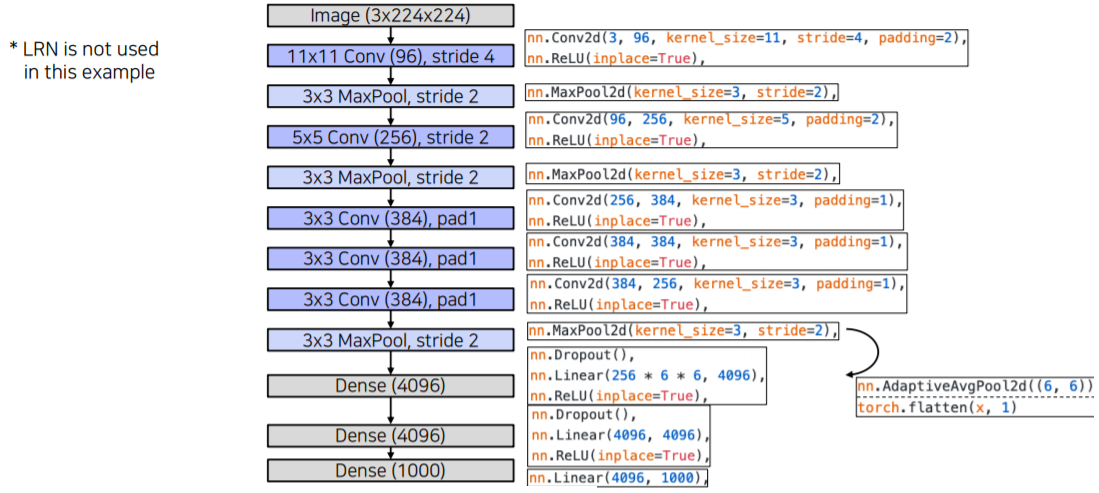
- max pooing 된 2d activation map이 linear layer로 가기 위해선 3d 구조에서 2d 구조로 벡터화를 해야한다
- 벡터화 옵션:
- average pooling
- flatten
- 위에 그림에서 눈여겨 볼것은 fc layer 의 dimension 이 여기서는 4096이다
- gpu용량 부족 문제로 그 당시에 학습할 때는 절반씩 각각 gpu에 올려서 학습했기 때문에 two stream 그림에서는 2048로 적혀있었던 것이다
- Conv - Pool - LRN - Conv - Pool - LRN - Conv - Conv - Conv - Pool - FC - FC - FC
AlexNet(deprecated components)
- local response normalization(LRN)
- activation map 에서 명암을 normalization하는 역할을 한다
- Lateral inhibition : the capacity of an excited neuron to subdue its neighbors
- LRN normalizes around the local neighborhood of the excited neuron
- Excited neuron becomes even more sensitive as compared to its neighbors
- 지금은 LRN 보다는 Batch normalization을 활용한다
- 11 x 11 convolution filter
- The filter size is increased, as the input size of the image has increased
- input size of LeNet: 28x28
- input size of AlexNet: 227x227
- Larger size filters are used to cover a wider range of the input image
- 최신 네트워크 구조에서는 큰 filter size 를 사용하지 않는다
- The filter size is increased, as the input size of the image has increased
AlexNet
- __Receptive field in CNN
- The region in the input space that a particular CNN feature is looking at
- suppose K x K convolution filters with stride 1, and a pooling layer of size P x P,
- then a value of each unit in the pooling layer depends on an input patch of size : (P + K - 1) x (P + K - 1)

VGGNet
- Deeper architecture
- 16 and 19 layers
- simpler architecture
- no local response normalization
- only 3x3 conv filters blocks, 2x2 max pooling
- better performance
- significant performance improvement over AlexNet(second in ILSVRC14)
- better generalization
- final features generalizing well to other taks even without fine-tuning
- summarize
- deeper architecture
- simpler architecture
- better performance
- better generalization
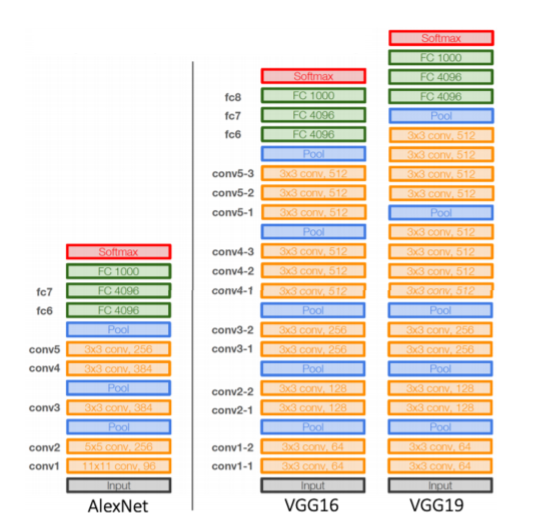
overall architecture
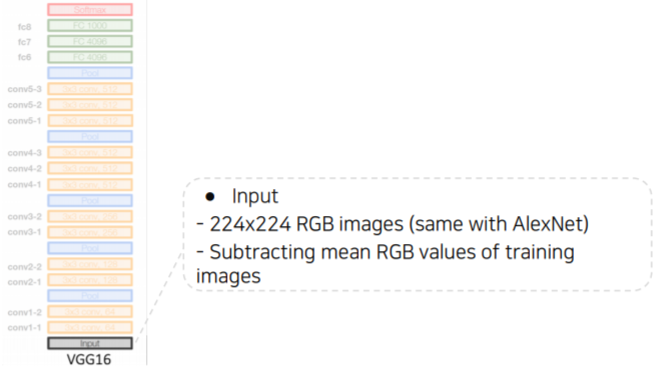
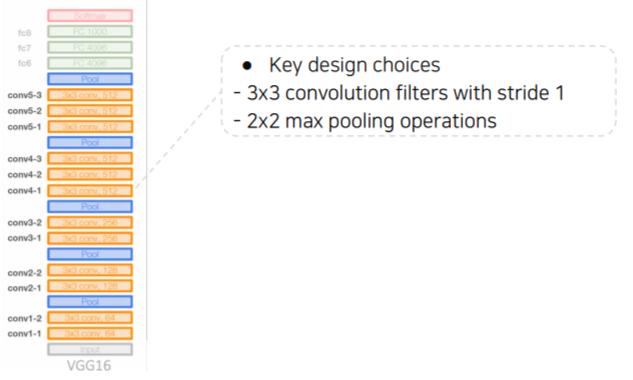
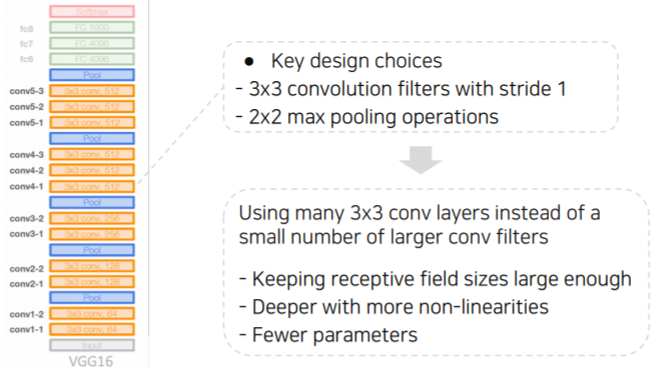
- 작은 convolution layer들도 stack을 많이 쌓으면 큰 receptive field size를 얻을 수 있다
- 큰 receptive field size를 input 단에서 얻었다는 의미는
- 이미지 영역에 많은 부분들을 고려해서 결론을 냈다는 의미와 동일하다
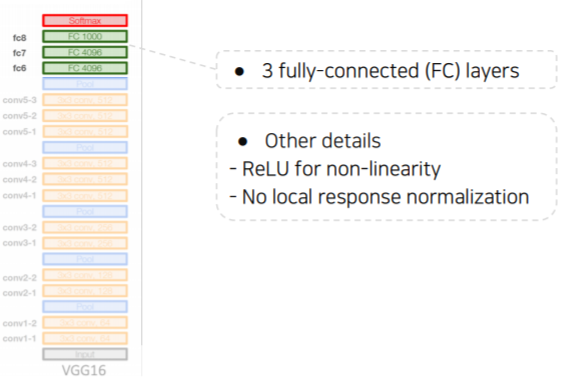
Annotation data(label data) efficient learning
- 컴퓨터 비전 문제를 푸는 딥러닝 모델은 supervised learning으로 학습하는 것이 유리하다는 사실은 알려져 있다
- 하지만, 딥러닝 모델을 학습할 수 있을 만큼 고품질의 데이터를 많이 확보하는 것은 보통 불가능하거나 그 비용이 매우 크다
- 여기에서는 Data Augmentation, Knowledge Distillation, Transfer learning, Learning without Forgetting, Semi-supervised learning 및 Self-training 등 주어진 데이터셋의 분포를 실제 데이터 분포와 최대한 유사하게 만들거나, 이미 학습된 정보를 이용해 새 데이터셋에 대해 보다 잘 학습하거나,
label이 없는 데이터셋까지 이용해 학습하는 등 주어진 데이터셋을 최대한 효율적으로 이용해 딥러닝 모델을 학습하는 방법을 소개한다
Further Reading
Data Augmentation
Learning representation of dataset
- learning representation from a dataset
- neural networks learn compact features(information) of a dataset
- Dataset is (almost) always biased
- Images taken by camera(training data) real data
- The training dataset is sparse samples of real data
- The training dataset contains only fractional part of real data
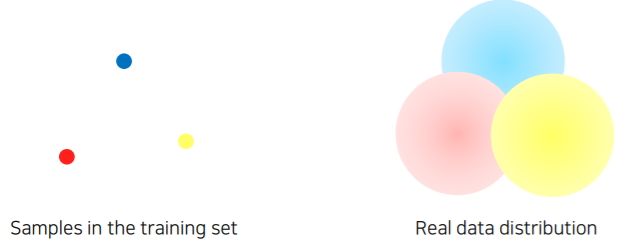
- The training dataset contains only fractional part of real data
- The training dataset and real data always have a gap
- Suppose a training dataset has only bright images
- during test time, if a dark image is fed as input, the trained model may be confused
- problem : datasets do not fully represent real data distribution

- Augmenting data to fill more space and to close the gap
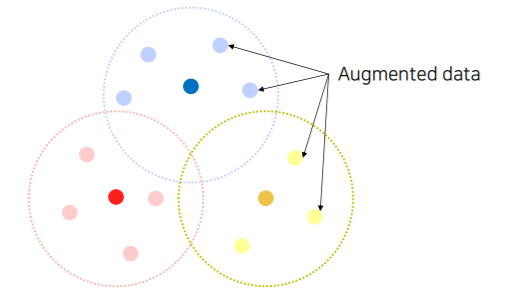
- examples of augmentations to make a dataset denser
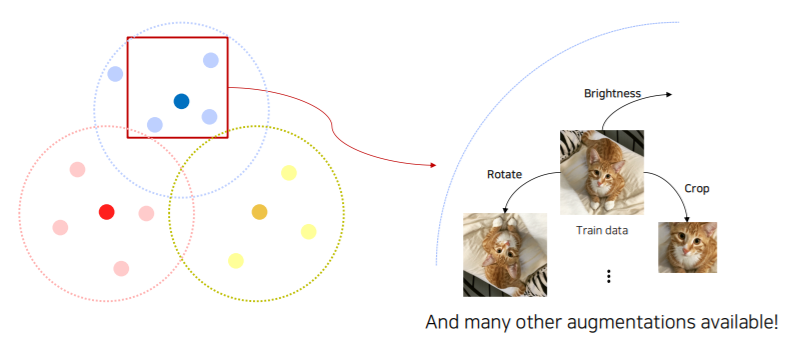
Data Augmentation
- image data augmentation
- applying various image transformations to the dataset
- crop, shear, brightness, perspective, rotate, etc.
- OpenCV and Numpy have various methods useful for data augmentation
- Goal: make training dataset's distribution similar with real data distribution
- applying various image transformations to the dataset
Various data augmentation methods
- brightness adjustment
- various brightness in dataset
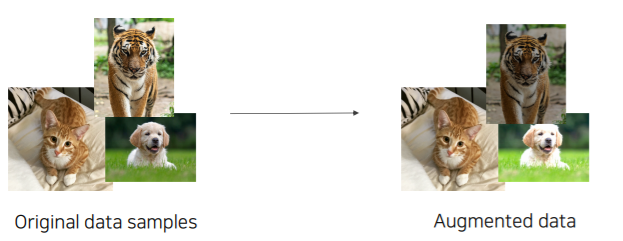
- brightness adjustment (brightening) using numpy
- various brightness in dataset
def brightness_augmentation(img):
# numpy array img has RGB value(0~255) for each pixel
img[:, :,0] = img[:, :,0] + 100 # add 100 to R value
img[:, :,0] = img[:, :,1] + 100 # add 100 to G value
img[:, :,0] = img[:, :,2] + 100 # add 100 to B value
img[:, :,0][img[:, :,0] > 255] = 255 # clip R values over 255
img[:, :,1][img[:, :,1] > 255] = 255 # clip G values over 255
img[:, :,2][img[:, :,2] > 255] = 255 # clip B values over 255
return img- Rotate, flip
- Diverse angles in dataset
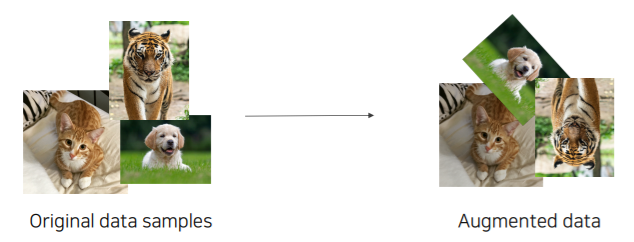
- Rotating (flipping) image using OpenCV
- Diverse angles in dataset
img_rotated = cv2.rotate(image, cv2.ROTATE_90_CLOCKWISE)
img_flipped = cv2.rotate(image, cv2.ROTATE_180)
- crop
- learning with only part of images
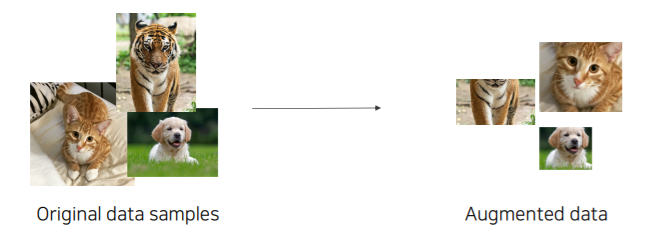
- cropping image using numpy
- learning with only part of images
y_start = 500 # y pixel to start cropping
crop_y_size = 400 # cropped image's height
x_start = 300 # x pixel to start cropping
crop_x_size = 800 # cropped image's width
img_cropped = image[y_start : y_start + crop_y_size, x_start : x_start + crop_x_size, :]
- Affine transformation
- preserve 'line', 'length ratio', and 'parallelism' in image
- for example, transforming a rectangle into a parallelogram
- see the shear transform example below

- see the shear transform example below
- Affine transformation (shear) using OpenCV
rows, cols, ch = image.shape
pts1 = np.float32([[50,50], [200,50], [50,200]])
pts2 = np.float32([[10,100], [200,50], [100,250]])
M = cv2.getAffineTransform(pts1, pts2)
shear_img = cv2.warpAffine(image, M, (cols, rows))
Model augmentation techniques
- CutMix
- 'Cut' and 'Mix training example to help model better localize objects

- 'Cut' and 'Mix training example to help model better localize objects
- Generating new training image
- mixing both images and labels
- 의미있는 수준의 성능 향상과 동시에 물체의 위치를 더 정교하게 catch 할수 있게끔 학습한다
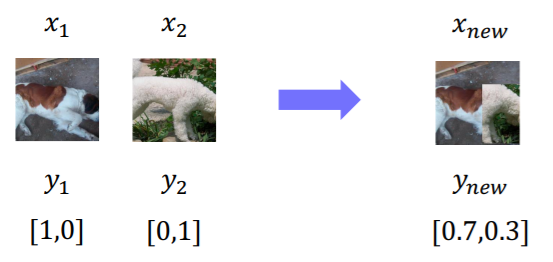
- 의미있는 수준의 성능 향상과 동시에 물체의 위치를 더 정교하게 catch 할수 있게끔 학습한다
- mixing both images and labels
- RandAugment
- 여러가지 영상 처리 기능들을 조화해서 전혀 다른 데이터를 생성한다
- many augmentation methods exist. Hard to find best augmentations to apply
- automatically finding the best sequence of augmentations to apply
- Random sample, apply, and evaluate augmentations
- 랜덤하게 augmentation기법들을 sampling해서 수행하고 성능이 잘 나오는 것을 활용

- 랜덤하게 augmentation기법들을 sampling해서 수행하고 성능이 잘 나오는 것을 활용
- example of augmented images in RandAug
- Augmentation policy has two parameters
- which augmentation to apply
- magnitude of augmentation to apply (how much to augment)

- parameters used in the above example
- which augmentations to apply : 'shearX' & 'AutoContrast'
- Magnitude of augmentations to apply : 9
- Augmentation policy has two parameters
- Randomly testing augmentations policies
- finding the best augmentations policy
- sample a policy : Policy = {N augmentations to apply} by random sampling
- train with a sampled policy, and evaluate the accuracy
- finding the best augmentations policy
- Augmentation helps model learning
- Higher test accuracy than training w/o augmentation
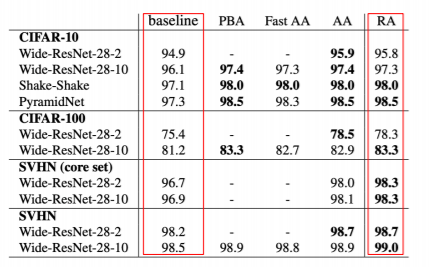
- Higher test accuracy than training w/o augmentation
Leveraging pre-trained information
Transfer learning
- The high-quality dataset is expensive and hard to obtain
- supervised learning requires a very large-scale dataset for training
- annotating data is very expensive, and its quality is not ensured
- transfer learning : A practical training method with a small dataset

- Benefits when using transfer learning
- by transfer learning, we can easily adapt to a new task by leveraging pre-trained knowledge(feature)!
- Motivational observation : similar datasets share common information
- 한 데이터셋에서 배운 지식을 다른 데이터셋에서 활용하는 기술
- E.g., 4 distinct datasets with similar images
- knowledge learned from one dataset can be applied to other datasets
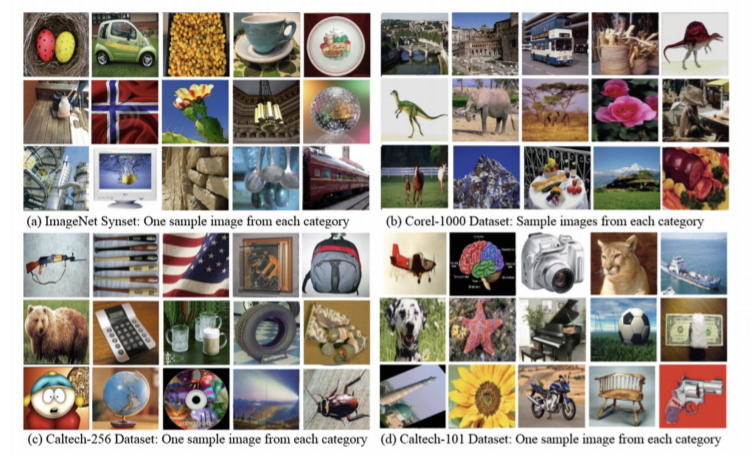
- Approach 1: Transfer knowledge from a pre-trained task to a new task
- Given a model pre-trained on a 10-class dataset,
- Chop off the final layer of the pre-trained model, add and only re-train a new FC layer
- Extracted features preserve all the knowledge from pre-training
- 새로운 task에 대응하도록 학습이 된게된다
- 이렇게 학습된 새로운 fc layer는 적은 데이터로 부터도 잘 작동되게 학습이 된다
- 몸통 전체를 학습시키지 않아도 되기때문에 학습해야할 파라미터수가 적어졌기 때문이다

- Approach 2: Fine-tuning the whole model
- Given a model pre-trained on a dataset
- Replace the final layer of the pre-trained model to a new one, and re-train the whole model
- set learning rates differently
- 아래 그림에서 convolution layer 부분은 learning rate을 낮게 잡고 학습을 같이한다
- learning rate를 낮게 잡은 부분은 업데이트가 느리게 되는 반면 새로운 fc layer는 높은 learning rate를 통해서 새로운 target task에 빨리 적응하도록 학습이 되게한다
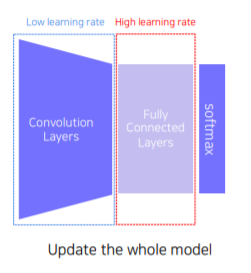
Knowledge distillation
- passing what model learned to 'another' smaller model(Teacher-student learning)
- 'Distillate' knowledge of a trained model into another smaller model
- used for model compression (Mimicking what a larger model knows)
- Also, used for pseudo-labeling (generating pseudo-labels for an unlabeled dataset)

- Teacher-student network structure
- the student network learns what the teacher network knows
- the student network mimics outputs of the teacher network
- 두 모델의 output의 차이를 KL div. Loss 를 통해 측정해서 backpropagation을 통해 student model 만 학습한다
- Unsupervised learning, since training can be done only with unlabeled data

- knowledge distillation
- when labeled data is available, can leverage labeled data for training(student loss)
- Distillation loss to 'predict similar outputs with the teacher model'
- Semantic information is not considered in distillation
- teacher에서 나온 output의 각각 dimension이 pre-train 할때 사용되었던 어떤 이전 task class 들과 연관이 되어있다
- student loss로 학습하는 데이터는 pre-training dataset과 전혀 다른 task 일 수 있다(label 정보가 겹치지 않는)
- 그래서 중복되는 정보가 없더라도 soft label에서 발생하는 output dimension들 각각의 그 의미가 중요하다기 보다는 전체 output이 추상적인 지식의 형태를 표현하고 있어서 그 행동 자체를 따라하도록 만드는 것이 가장 중요하지 그 내부 각각 element의 semantic information이 중요한건 아니다 라는 의미

- Hard label vs Soft label
- Hard label(ground truth, one-hot vector)
- typically obtained from the dataset
- indicates whether a class is 'true answer' or not
- Soft label
- typical output of the model(=inference result)
- regard it as 'knowledge'. Useful to observe how the model thinks

- Hard label(ground truth, one-hot vector)
- softmax with temperature()
- Softmax with temperature: controls difference in output between small & large input values
- A large smoothens large input value differences
- 극단적으로 0과 1의 값만 있는것 보단 0과 1 사이의 중간 값도 가지면서 입력에 따라 민감하게 변하는 신호를 따라하게 만듬으로서 student가 teacher를 더 따라하게 도와주는 역할
- Useful to synchronize the student and teacher models' outputs

- intuition about distillation loss and student loss
- Distillation loss
- KLdiv(soft label, soft prediction)
- Loss = difference between the teacher and student network's inference
- Learn what teacher network knows by mimicking
- Student Loss
- CrossEntropy(hard label, soft prediction)
- Loss = difference between the student network's inference and tru label
- Learn the 'right answer'
- Distillation loss
- Loss functions in knowledge distillation
- Weighted sum of 'distillation loss' and 'student loss'

- Weighted sum of 'distillation loss' and 'student loss'
Leveraging unlabeled dataset for training
Semi-supervised learning
- There are lots of unlabeled data
- typically, only a small portion of data is labeled
- is there any way to learn from unlabeled data?
- Semi-supervised learning : Unsupervised (no label) + Fully supervised (fully labeled)
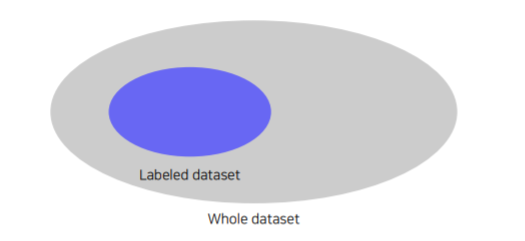
- Semi-supervised learning with pseudo labeling
- pseudo-labeling unlabeled data using a pre-trained model, then use for training
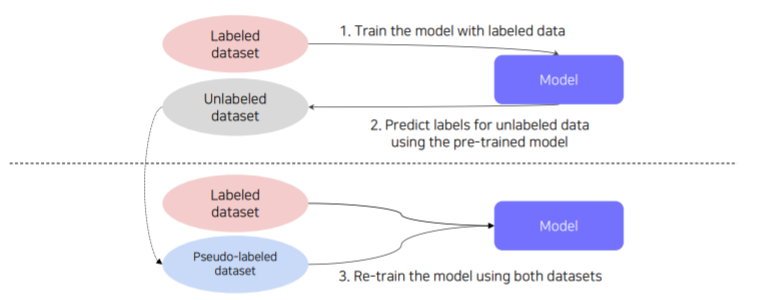
- pseudo-labeling unlabeled data using a pre-trained model, then use for training
Self-training
- Recap : Data efficient learning methods so far
- Data Augmentation
- Augment a dataset to make the dataset closer to real data distribution
- knowledge distillation
- train a student network to imitate a teacher network
- transfer the teacher network's knowledge to the student network
- semi-supervised learning (Pseudo label-based method)
- Pseudo-label an unlabeled dataset using a pre-trained model, then use for training
- Leveraging an unlabeled dataset for training
- Data Augmentation
- self-training
- Augmentation + teacher-student networks + semi-supervised learning
- SOTA ImageNet Classification, 2019
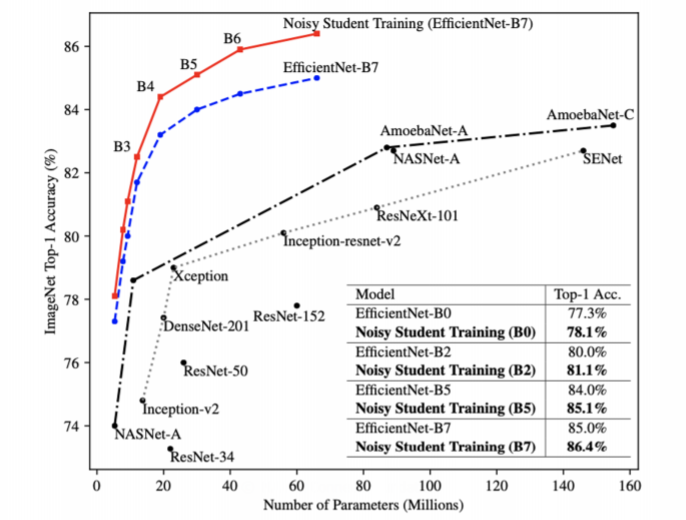
- self-training with noisy student
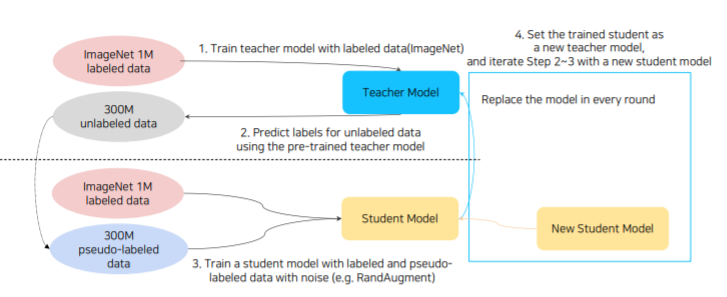
- iteratively training noisy student network using teacher network
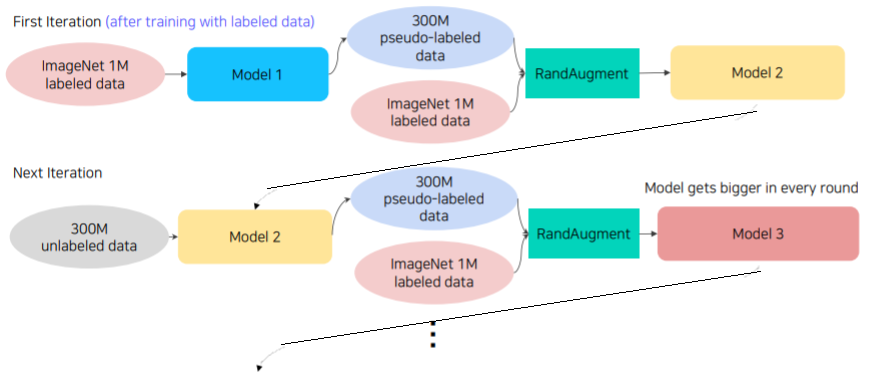
- brief overview of self-training
- Train initial teacher model with labeled data
- pseudo-label unlabeled data using teacher model
- train student model with both labeled and unlabeled data with augmentation
- set the student model as a new teacher, and set new model(bigger) as a new student
- repeat 2~4 with new teacher/student models
Reference
- Data augmentation
- Yun et al.,CutMix:Regularization Strategy to Train Strong Classifiers with Localizable Features,ICCV2019
- Cubuk et al.,Randaugment:Practical automated data augmentation with a reduced search space,CVPRW 2020
- Leveraging pre-trained information
- Ahmed et al.,Fusion of local and global features for effective image extraction, Applied Intelligence 2017
- Oquab et al.,Learning and Transferring Mid- Level Image Representations using Convolutional Neural Networks, CVPR 2015
- Hinton et al.,Distilling the Knowledge in a Neural Network, NIPS deep learning workshop 2015
- Li & Hoiem, Learning without Forgetting, TPAMI 2018
- Leveraging unlabeled dataset for training
- Lee,Pseudo-label: The simple and Efficient Semi-Supervised Learning Method for Deep Neural Networks, ICML Workshop 2013
- Xie et al., Self-training with Noisy Student improves ImageNet classification, CVPR 2020
